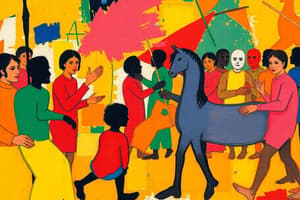Podcast
Questions and Answers
What do Fundamental Rights in the Indian Constitution ensure?
What do Fundamental Rights in the Indian Constitution ensure?
- Absolute power to the government without checks
- Civil liberties and protections against abuse (correct)
- Exclusive rights for a particular group of individuals
- Rights that can be revoked at any time
What are some objectives of the Directive Principles of State Policy in the Indian Constitution?
What are some objectives of the Directive Principles of State Policy in the Indian Constitution?
- Ensuring complete freedom without any restrictions
- Promoting social welfare objectives like equality and justice (correct)
- Empowering the military with unlimited authority
- Privileging the wealthy over the poor
When was the final version of the Indian Constitution adopted?
When was the final version of the Indian Constitution adopted?
- November 26, 1949 (correct)
- March 3, 1947
- January 26, 1950
- July 15, 1948
What key feature was incorporated into the Indian Constitution to allow for future changes based on evolving needs?
What key feature was incorporated into the Indian Constitution to allow for future changes based on evolving needs?
Who became the President of the Republic of India under the new constitution on January 26, 1950?
Who became the President of the Republic of India under the new constitution on January 26, 1950?
How many parts did the final version of the Indian Constitution contain?
How many parts did the final version of the Indian Constitution contain?
When did India adopt the Constitution of India?
When did India adopt the Constitution of India?
What was the role of the Nehru Report Committee in the formation of the Indian Constitution?
What was the role of the Nehru Report Committee in the formation of the Indian Constitution?
Which event led to the partition of India and Pakistan into separate states?
Which event led to the partition of India and Pakistan into separate states?
What was the significance of the Constituent Assembly in the formation of the Indian Constitution?
What was the significance of the Constituent Assembly in the formation of the Indian Constitution?
Which document served as interim legislation until a permanent constitution could be established in India?
Which document served as interim legislation until a permanent constitution could be established in India?
What was one key proposal made by the Cabinet Mission during its visit to India?
What was one key proposal made by the Cabinet Mission during its visit to India?
Flashcards are hidden until you start studying
Study Notes
After gaining independence from Britain in August 1947, India faced several challenges in its journey towards establishing itself as a democratic republic with a representative form of government. One significant milestone was the adoption of the Constitution of India on January 26, 1950. This document laid down the foundation of governance in India and it remains one of the longest constitutions in existence today. Here's a brief overview of some key events related to the formation of the Indian Constitution:
Preparing for Independence: 1946–1949
Before independence, the Indian National Congress had been working on drafting a constitution since 1928 through various committees such as the Nehru Report Committee. In 1946, the Cabinet Mission visited India and proposed a new constitutional arrangement which would allow two entities, the Union of India and the Dominion of Pakistan, to share power and resources while remaining independent. However, this proposal led to tensions between India and Pakistan, eventually causing their partition into separate states.
After partition, India continued its efforts towards achieving home rule within the British Empire by adopting the Government of India Act 1935 as interim legislation until a permanent constitution could be established. By December 1948, a Constituent Assembly consisting of 299 members representing different regions and interests across India began work on creating the country’s first formal constitution.
Drafting of the Constitution: 1947–1949
The Constitutional Assembly worked diligently over more than two years, debating and refining drafts of the constitution before finalizing them. Some notable highlights during this period included the addition of Directive Principles of State Policy, designed to guide state policy towards social welfare objectives like equality, justice, and fraternity; and Fundamental Rights, ensuring civil liberties and protections against abuse. Additionally, an amendment process was incorporated into the document, allowing for future changes based on evolving needs.
Adoption of the Constitution: 1949–1950
On November 26, 1949, the final version of the Constitution was adopted by the assembly, making India the world's largest democracy. It contained a preamble, 22 parts, 12 schedules, and 395 clauses covering all aspects of governance including fundamental rights, directive principles, executive powers, parliamentary system, judiciary, emergency provisions, territorial organization, and more. Finally, on January 26, 1950, Dr Rajendra Prasad became the President of the newly formed Republic of India under the new constitution, inaugurating an era of stability and progress for the nation.
Studying That Suits You
Use AI to generate personalized quizzes and flashcards to suit your learning preferences.




